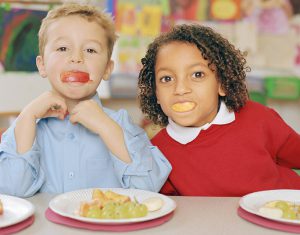The South African Schools Collection
Become A Lunchbox Legend
Ensuring children get the nutrition they need to grow strong and cope with their schoolwork doesn’t just mean focusing on what children eat at home – it also means paying attention to what they get in their lunchboxes at school.
Getting this right isn’t just about putting in a few of their favourite snacks; it’s about understanding what food groups children should be getting in general, and how often they need them.
The food groups
According to Deborah Jacobson, a dietician with a special interest in children, there are three major food groups for children: energy foods, comprising carbohydrates and healthy fats; growing and building foods, which are proteins like eggs, meat and cheese; and fruit and vegetables.
“You should try to get your children to enjoy each of these in equal portions in a day,” she says.
Fruit and vegetables are a particular focus area, because kids seldom get enough of these. Any person should get five helpings of fruit and vegetables a day, with a helping being a portion the size of their fist.
The good news is that if your children prefer fruit or vegetables, Jacobson says it’s fine to get one or the other.
“You don’t have to eat vegetables if you are getting enough fruit, and vice versa,” she says.
However, she says that if a child is eating two fruits at breakfast, two vegetables at dinner and a fruit snack when they get home from school, it’s not necessary for them to have a piece of fruit in their lunchbox as well. “But they should get their energy foods and their growing and building foods throughout the day, not just at one meal,” she says.
She also says that carbohydrates have been given a bad reputation, and parents are trying to eliminate them from their children’s diets, which she says is really not a good idea.
“Children need the energy. They need a starch – a complex carbohydrate – so that they can concentrate,” says Jacobson.
Complex carbohydrates include wholegrain breads and crackers, potato salad or wholegrain pasta, but Jacobson acknowledges that you have to be practical about what your children will eat as well.
“I find that you can get away with including one wholegrain piece of bread if you cut it into a shape, and perhaps provide it as part of a sandwich with the bread they prefer as well.”
Good proteins to include are a piece of cold meat, a boiled egg, peanut butter on a sandwich or even mini drinking yoghurts.
“Normal yoghurt tends to get warm and yucky, but drinking yogurt is still appealing later in the day,” she says. “Beans and other pulses are also great, but quite tricky to include as part of a packed lunch, unless your child really likes them.”
It’s got to look good
She says parents should focus on providing food that’s visually appealing. “Children like to have simple foods, and they like it to be in different compartments with divisions or different containers. They are always looking at their friends’ food to see who has something more exciting, so visual appeal is important.”
As for foods to avoid, she says it’s not necessary to include a sweet, except as a rare treat. Most schools now forbid parents to send their children to school with sweets anyway. Instead, include nuts and raisins, biltong, popcorn or a small biscuit – preferably wholegrain.
“And there’s no need to give a child juice either. They shouldn’t have more than one a day, so if they get juice at home, don’t send one to school. Water is the best thing,” she says.
Jacobson gives us a snapshot of an ideal lunchbox:
- A wholegrain wrap with veggies and chicken or tuna;
- Veggies cut into easy-to-eat pieces, with a dip like hummus or tzatziki;
- A tub of fruit salad, made from their favourite fruits;
- A small packet of peanuts and raisins; and
- A bottle of water.
Top tips from parents
Parents believe that you have to give your children what they like – as long as it’s healthy. “I give them carrot sticks, cherry tomatoes, strawberries, yoghurt and cheese dippers, because those are the things they like,” says Kath Wimbush.
Rosalind Butler’s kids get peanut butter sandwiches and chicken wraps with sweet chilli sauce, because “they love them”. She also packs in fresh or dried fruit, droëwors if it’s going to be a long day, and “whatever cake or muffins or other baked thing we have in the house.” She also makes leftovers work for her by putting bits of roast lamb or Bolognese sauce into a pita.
Elaine Moriarty says that her children get carrot sticks and peanut butter, nuts, biltong, fruit, hummus and cucumber or rice crackers, strips of cheddar eaten with a whole crunchy apple, and yoghurt, “because they love them all”.
Tiffany Markman says that you also need to understand what kind of eater your child is. “Our daughter is a constant grazer, not a meal eater. So we give her snacky type food, like berries, cherry tomatoes, raisins, fresh peas and biltong”.
Joanne Macgregor says her daughter goes through phases of loving certain things – samoosas, curry rotis, filled mini-vetkoeks – but that they suddenly become no-gos again. “Now that she’s in matric and has access to a microwave, we can also include things like ravioli in sauce or pies,” she says.
One of her top tips is to make guacamole, pushed into the corner of a sandwich bag and twisted and tied so that air exposure doesn’t turn it brown, and send it to school with crackers.
Heidi Raj also makes judicious use of leftovers – or any combo of cold meat and vegetables – by making them into an egg muffin. “Simply mix with an egg and dollop into a muffin tray. You can make them in advance and then use them later in the week.” She also makes her kids sushi, prepping the rice the night before, and them assembling nori rolls with cucumber quickly in the morning before school.
Caroline McCann, owner of the Braeside Butchery and organiser of the Skaftini Challenge (see sidebar) says that the easiest way to break down barriers that kids have with meals is to get them involved in preparation. “Make lists of food that your child enjoys that are healthy, keep those foods in the fridge and let your children work with you to prepare and pack their lunchbox. When they’re bigger, they can even do this on their own,” she says.
Gcobisa May says that because she is a healthy eater at home, she always has healthy food in the house, so that’s what she packs for school lunches. “I use seeded, whole-wheat, rye and low-GI bread with healthy fillings like fresh veggies – tomato, lettuce or cucumber. For snacks, I include sweetcorn, celery, Rosa tomatoes and hummus. They only get treats on weekends.” She also buys magazines with lunchbox tips and cycles through all their suggestions in a month.
And Jason Norwood-Young, when asked what he includes in his kids’ lunchboxes, echoed something all parents have experienced. “I put fruit in their lunchboxes in the morning. In the afternoon, I take bruised, squidgy fruit out of their lunchboxes.”
The Skaftini Challenge
Last year, a competition called the Skaftini Challenge was held for the first time at the Soweto Eat-In 2017. Eight Johannesburg chef schools were invited to participate and create a skaftini (child’s lunch box) that was healthy, tasty and nutritious, and used local produce. Their efforts were judged by an expert panel according to strict criteria.
The winning skaftini was created by Prue Leith Cooking School students Lithalethu Mtshabe, Michelle Smith and Jack Baldock and contained beef and lentil meatballs with amasi and herb dip on sorghum tabbouleh. Treats included oat, rosemary and date crunchies as well as a dried pear and coconut truffle, and orange and rooibos ice tea.






 Sign-up and receive the Business Media MAGS newsletter OR SA Mining newsletter straight to your inbox.
Sign-up and receive the Business Media MAGS newsletter OR SA Mining newsletter straight to your inbox.